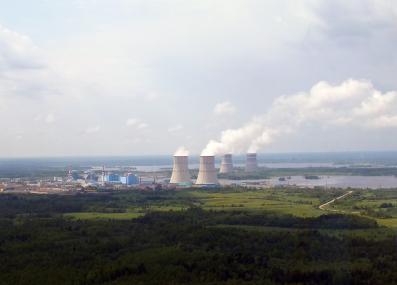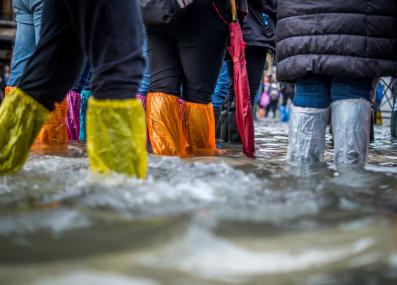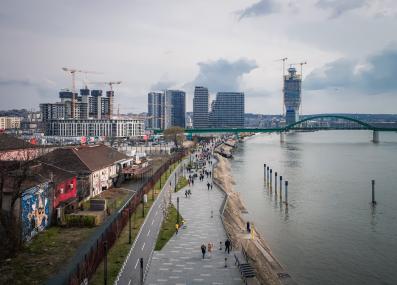Have a question?
Are coastal nuclear power plants at risk from sea level rise and climate change?
Nuclear power plants are held to exceptionally high standards of readiness for natural disasters. But as the planet warms, some may need to prepare for increased hazards—including rising seas and more severe hurricanes.
September 23, 2025
As sea levels rise and hurricanes grow more intense, the infrastructure in their path includes a large share of the world’s nuclear power plants. China, for instance, is building nuclear energy faster than any other country—concentrated along the Pacific Ocean.1
The main reason to locate nuclear plants by the sea is because coastal areas attract large cities, and those cities need energy. But it’s also good engineering, says Curtis Smith, professor of nuclear science and engineering at MIT and a specialist in nuclear safety and regulations. A nuclear reactor generates immense heat, and that heat needs to be safely transferred to the plant’s turbines to make electricity. Typically, plants use pumped-in water for this purpose. Water is also used to shed excess heat from the reactor, protecting it from meltdown.
“If you have water nearby, you use it,” says Smith. “So there are a lot of nuclear power plants by coastlines and waterways.”
Climate change presents increased hazards for these plants. On average, sea levels have risen 8 to 9 inches over the past century, exposing many coastal areas to more flooding—with further and faster rise on the way.2 Warming oceans also fuel more powerful hurricanes, whose lashing winds, torrential rainfall and storm surges all threaten coastal infrastructure.
Nuclear engineers and regulators should factor these hazards into their planning, Smith says. But, he adds, nuclear power plants have a head start over other vital infrastructure when it comes to managing climate risks.
“I think nuclear power is well-suited for climate change, because we have high safety margins,” Smith says. “We tend to overbuild on the engineering in terms of what hazards we might actually see. But it's good to have that extra margin when we run these plants for 50 or 60 years.”
Nuclear safety is a serious issue. If a nuclear plant loses the ability to cool its reactor fuel, it can release radioactive materials and contaminate the surrounding area. For this reason, nuclear power is the most stringently regulated energy source in the U.S. and worldwide. Strict safety practices have helped ensure that accidents are extraordinarily rare: In fact, nuclear energy has caused much less illness and death than fossil fuel power, which creates its own mix of toxic pollutants.3
Key to that record, says Smith, are the rigorous standards to which nuclear engineers hold their designs.
In a typical construction project—including most power plants—engineers will decide on a level of risk tolerance and build accordingly, with the expectation that failures will be rare. For example, a bridge might be built to withstand a “100-year flood,” or a level of flooding that has a 1% chance of occurring in any given year.
In nuclear engineering, it’s common to go beyond this focus on probability. “When we build our models for natural hazards, we do look at statistics, but there's also this concept of physical processes,” says Smith. “How high can wind actually blow in a hurricane? How much water can you physically push when you have a tsunami?”
That doesn’t make nuclear plants invulnerable to climate change. In some cases, our warming planet may change the physical limits of nature; for instance, a warmer atmosphere can hold more water and produce more rain. But building for the largest possible storm instead of the largest likely storm does give nuclear power a valuable cushion, Smith says. “Say the rainfall event we design for would give us 10 inches of rain in one day. Climate change may make that worse, and we would want to accommodate that, but one thing we wouldn't expect is for that 10 inches to immediately jump to a 100-inch rain event. And the fact that we look at a variety of hazards this way forces us to be pretty far on the safe side.”
It’s also standard practice for nuclear plants to use “defense in depth,” with multiple ways to deal with any single hazard. For example, a coastal nuclear plant might have a flood wall as a first layer of defense against flooding; interior flood doors; and pumps to flush out any water that still penetrates inside.
Even with all this planning, natural disasters can still threaten nuclear power. The most significant nuclear incident of the past 30 years occurred when a tsunami struck Japan’s Fukushima Daiichi Nuclear Power Plant in 2011. The disaster had no relationship to climate change, but it does illustrate the profound dangers of flooding in a nuclear plant. As the plant absorbed a wave over 40 feet high, floodwaters wrecked the electrical systems, and workers found they could not pump water into one of the plant’s reactors, which overheated.
Specialists later found issues with Fukushima Daiichi’s design and emergency response, leading to reforms in Japan and worldwide. In the U.S., the nuclear industry adopted a program called FLEX, which calls for nuclear plants to have additional backup power and water sources remote from the main facility, so that reactors can be cooled even when a disaster knocks the primary systems offline.
Some plants may need to take further action to adapt to climate change. The Turkey Point Nuclear Plant outside Miami has become a flashpoint for this issue. During a review of nuclear safety practices after Fukushima, Turkey Point’s operator acknowledged that its existing flood defenses were not equipped to handle higher sea levels,4 and submitted a plan for upgrades and new emergency response procedures to the Nuclear Regulatory Commission (NRC).5 The upgrades were completed over the next three years.
Environmental advocacy groups raised concerns about sea level rise again in 2018, when the operator requested that Turkey Point’s license be extended into the 2050s. After a lengthy review process, the NRC concluded that Turkey Point’s safety margins are sufficient to keep operating through that time (a decision that has not satisfied all the power plant’s critics).6
Smith says he understands the concerns about Turkey Point, and adds that this ongoing conversation about climate risks is healthy for nuclear power. “We want to be sure that we're ready for the future,” he says. “So Turkey Point was allowed to move forward with their license extension, but it was a good example of the questioning attitude I think we have in the nuclear industry. And the public plays an important part in that.”
Thank you to Robert Menzies-Conacher of the United Kingdom for the question.
Submit your own question to Ask MIT Climate
Get the latest from Ask MIT Climate monthly in your inbox
1 Global Energy Monitor: "China is building half of the world’s new nuclear power despite inland plants pause." Joe Bernardi and Ye Huang, August 2024.
2 National Oceanic and Atmospheric Administration: "Climate Change: Global Sea Level." August 22, 2023.
3 Our World in Data: "What are the safest and cleanest sources of energy?" Hannah Ritchie, February 10, 2020. Last updated March 2024. Underlying data from:
Sovacool, Benjamin, et al. "Balancing safety with sustainability: assessing the risk of accidents for modern low-carbon energy systems." Journal of Cleaner Production 112 (2016). https://doi.org/10.1016/j.jclepro.2015.07.059.
Markandya, Anil, and Paul Wilkinson. "Electricity generation and health." The Lancet 370 (2007). https://doi.org/10.1016/S0140-6736(07)61253-7
United Nations Scientific Committee on the Effects of Atomic Radiation. "Sources and Effects of Ionizing Radiation." UNSCEAR 2008 Report to the General Assembly with Scientific Annexes (2008).
With additional data from the government of Japan.
4 Florida Power and Light. Re: Turkey Point Unit 3 and Unit 4. NEI 12-06, Revision 2, Appendix G, G.4.2, Mitigating Strategies Assessment (MSA) for FlEX Strategies report for the New Flood Hazard Information. December 20, 2016.
5 Florida Power and Light. Re: Turkey Point Unit 3 and Unit 4. Flooding Focused Evaluation Summary. Docket Nos. June 29, 2017.
6 United States Nuclear Regulatory Commission. Site-Specific Environmental Impact Statement for License Renewal of Nuclear Plants Supplement 5a, Second Renewal Regarding Subsequent License Renewal for Turkey Point Nuclear Generating Unit Nos. 3 and 4, Final Report. March 2024.










